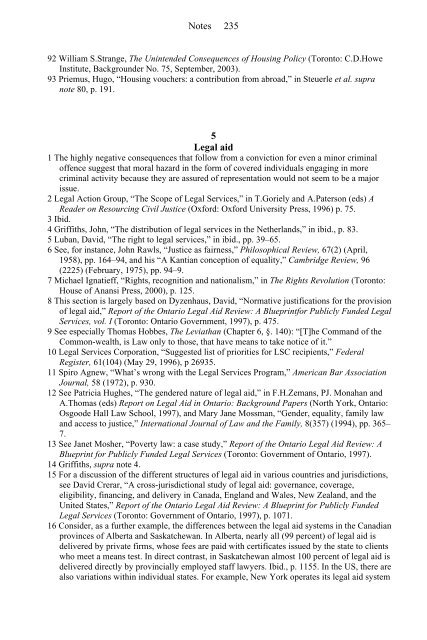Rethinking the Welfare State: The prospects for ... - e-Library
Rethinking the Welfare State: The prospects for ... - e-Library
Rethinking the Welfare State: The prospects for ... - e-Library
Create successful ePaper yourself
Turn your PDF publications into a flip-book with our unique Google optimized e-Paper software.
Notes 235<br />
92 William S.Strange, <strong>The</strong> Unintended Consequences of Housing Policy (Toronto: C.D.Howe<br />
Institute, Backgrounder No. 75, September, 2003).<br />
93 Priemus, Hugo, “Housing vouchers: a contribution from abroad,” in Steuerle et al. supra<br />
note 80, p. 191.<br />
5<br />
Legal aid<br />
1 <strong>The</strong> highly negative consequences that follow from a conviction <strong>for</strong> even a minor criminal<br />
offence suggest that moral hazard in <strong>the</strong> <strong>for</strong>m of covered individuals engaging in more<br />
criminal activity because <strong>the</strong>y are assured of representation would not seem to be a major<br />
issue.<br />
2 Legal Action Group, “<strong>The</strong> Scope of Legal Services,” in T.Goriely and A.Paterson (eds) A<br />
Reader on Resourcing Civil Justice (Ox<strong>for</strong>d: Ox<strong>for</strong>d University Press, 1996) p. 75.<br />
3 Ibid.<br />
4 Griffiths, John, “<strong>The</strong> distribution of legal services in <strong>the</strong> Ne<strong>the</strong>rlands,” in ibid., p. 83.<br />
5 Luban, David, “<strong>The</strong> right to legal services,” in ibid., pp. 39–65.<br />
6 See, <strong>for</strong> instance, John Rawls, “Justice as fairness,” Philosophical Review, 67(2) (April,<br />
1958), pp. 164–94, and his “A Kantian conception of equality,” Cambridge Review, 96<br />
(2225) (February, 1975), pp. 94–9.<br />
7 Michael Ignatieff, “Rights, recognition and nationalism,” in <strong>The</strong> Rights Revolution (Toronto:<br />
House of Anansi Press, 2000), p. 125.<br />
8 This section is largely based on Dyzenhaus, David, “Normative justifications <strong>for</strong> <strong>the</strong> provision<br />
of legal aid,” Report of <strong>the</strong> Ontario Legal Aid Review: A Blueprint<strong>for</strong> Publicly Funded Legal<br />
Services, vol. I (Toronto: Ontario Government, 1997), p. 475.<br />
9 See especially Thomas Hobbes, <strong>The</strong> Leviathan (Chapter 6, §. 140): “[T]he Command of <strong>the</strong><br />
Common-wealth, is Law only to those, that have means to take notice of it.”<br />
10 Legal Services Corporation, “Suggested list of priorities <strong>for</strong> LSC recipients,” Federal<br />
Register, 61(104) (May 29, 1996), p 26935.<br />
11 Spiro Agnew, “What’s wrong with <strong>the</strong> Legal Services Program,” American Bar Association<br />
Journal, 58 (1972), p. 930.<br />
12 See Patricia Hughes, “<strong>The</strong> gendered nature of legal aid,” in F.H.Zemans, PJ. Monahan and<br />
A.Thomas (eds) Report on Legal Aid in Ontario: Background Papers (North York, Ontario:<br />
Osgoode Hall Law School, 1997), and Mary Jane Mossman, “Gender, equality, family law<br />
and access to justice,” International Journal of Law and <strong>the</strong> Family, 8(357) (1994), pp. 365–<br />
7.<br />
13 See Janet Mosher, “Poverty law: a case study,” Report of <strong>the</strong> Ontario Legal Aid Review: A<br />
Blueprint <strong>for</strong> Publicly Funded Legal Services (Toronto: Government of Ontario, 1997).<br />
14 Griffiths, supra note 4.<br />
15 For a discussion of <strong>the</strong> different structures of legal aid in various countries and jurisdictions,<br />
see David Crerar, “A cross-jurisdictional study of legal aid: governance, coverage,<br />
eligibility, financing, and delivery in Canada, England and Wales, New Zealand, and <strong>the</strong><br />
United <strong>State</strong>s,” Report of <strong>the</strong> Ontario Legal Aid Review: A Blueprint <strong>for</strong> Publicly Funded<br />
Legal Services (Toronto: Government of Ontario, 1997), p. 1071.<br />
16 Consider, as a fur<strong>the</strong>r example, <strong>the</strong> differences between <strong>the</strong> legal aid systems in <strong>the</strong> Canadian<br />
provinces of Alberta and Saskatchewan. In Alberta, nearly all (99 percent) of legal aid is<br />
delivered by private firms, whose fees are paid with certificates issued by <strong>the</strong> state to clients<br />
who meet a means test. In direct contrast, in Saskatchewan almost 100 percent of legal aid is<br />
delivered directly by provincially employed staff lawyers. Ibid., p. 1155. In <strong>the</strong> US, <strong>the</strong>re are<br />
also variations within individual states. For example, New York operates its legal aid system


